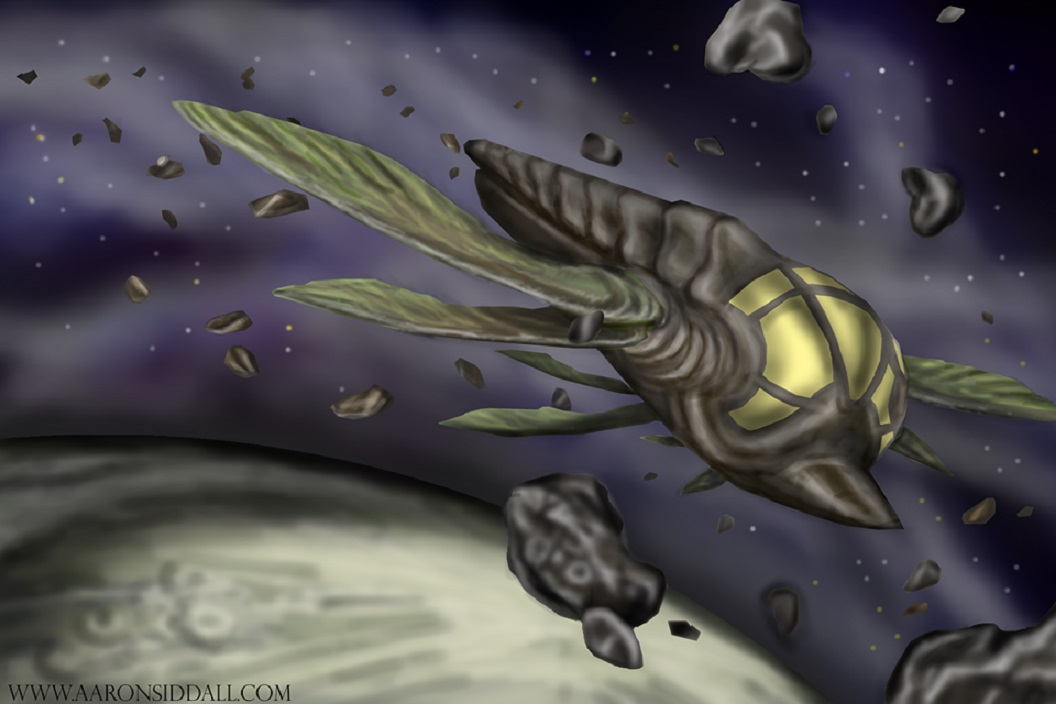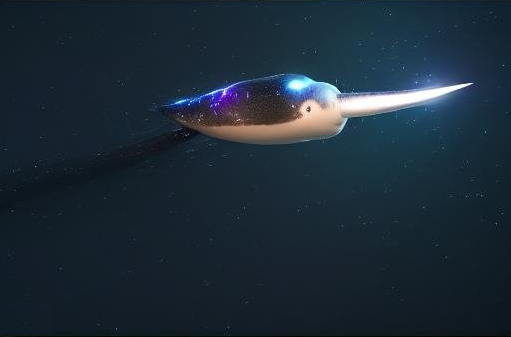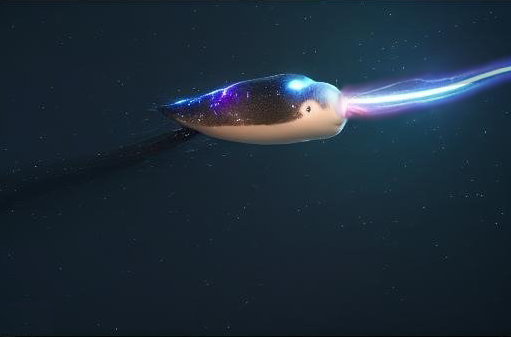Space Narwhal ([ speys NAHR-wuhl ] | / speɪs ˈnɑr wəl /)
Oh! (laugh) Oh lad, that's not a unicorn horn. That's from a space narwhal. But I'll tell ye what; ye can sell that at the star-docks for a fine price anyway. Just make sure ye show it to ship pursers, and let 'em know ye know what ye've got there, afore ye get taken for a fool again!A space narwhal is a spacefaring mammal with a superficial resemblance to maritime narwhals. It also occupies a similar ecological niche in the spaceways. It is known for its unique "unicorn horn," which is actually a modified tusk. This horn contains enough Starmetal that it is often an overwhelming temptation for hunters to poach and violate quotas. Their large quantities of blubber are also highly valued.
Basic Information
Anatomy
Space narwhals are medium-sized star-whales. Total length in both sexes, excluding the tusk, can range from 3.95 to 5.5 m (13 to 18 ft). Males, at an average length of 4.1 m (13.5 ft), are slightly larger than females, with an average length of 3.5 m (11.5 ft). Typical adult body weight ranges from 800 to 1,600 kg (1,760 to 3,530 lb). Male narwhals attain sexual maturity at 11 to 13 years of age, when they are about 3.9 m (12.8 ft) long. Females become sexually mature at a younger age, between 5 and 8 years old, when they are around 3.4 m (11.2 ft) long.
The colouration of a space narwhal is white on its underside, and speckled with patterns resembling stars and nebulae in the blackness of the Void on the upper portions. They are darkest when born and become brighter with age.
Narwhals do not have fins, possibly an evolutionary adaptation to reduce surface area and heat loss, or reduce drag. Instead, space narwhals possess a shallower dorsal ridge. Their neck vertebrae are jointed, like those of land mammals, instead of being fused together as in most star-whales, allowing a great range of neck flexibility. The tail flukes of space narwhals have front edges that are concave and lack a sweep-back. This is thought to be an adaptation for reducing drag caused by the tusk.
The most conspicuous characteristic of the space narwhal is a single long tusk, which is in fact a canine tooth that projects from the left side of the upper jaw, through the lip, forming a counterclockwise helical spiral. The tusk grows throughout life, reaching a length of about 1.5 to 3.1 m (4.9 to 10.2 ft). It is hollow and weighs around 10 kg (22 lb). About one in 500 space narwhals has two tusks, occurring when the right canine also grows out through the lip.
The tusk, or "narwhal horn," appears to be a naturally-occuring Starfaring Engine, containing enough Starmetal to interact with a small disk of Mithril located in the space narwhal's palate. One of the more spectacular sights in the spaceways of the Core Worlds is a space narwhal forming a glowing interplanetary Airt extending from its horn. Naturalists believe the space narwhal manages this by using its melon and tongue to vibrate the thin sheet of mithril in its palate, thus activating the starfaring function of the organ.
The tusks are surrounded by several small vestigial teeth which vary in morphology. These teeth can sometimes be extruded from the bone, but mainly reside inside open tooth sockets in the space narwhal's snout alongside the tusks. They seem to serve no current purpose, and may be evolutionary remnants.
Space narwhals must breathe, but seem to be able to generate their own Etheric Membranes. They can also hold their breath for days to weeks if necessary.
Genetics and Reproduction
Females start bearing calves when six to eight years old. Adult space narwhals mate once a year, and only in areas where food is plentiful. Gestation lasts for 14 months. Only a single calf is born, averaging 1.6 metres (5.2 feet) in length.
Hybrids have been documented between the space narwhal and space beluga (specifically a beluga male and a narwhal female), as one, perhaps even as many as three, were killed and harvested during a sustenance hunt. Whether or not these hybrids could breed remains unknown. The unusual pattern of teeth seen in the specimens indicates the hybrids hunted on the seabed, much as walruses do, suggesting feeding habits that differ from those of either parent species.
Newborn calves begin their lives with a thin layer of blubber which thickens as they nurse their mother's milk which is rich in fat. Calves are dependent on milk for around 20 months. This long lactation period gives calves time to learn skills needed for survival during maturation when they stay within two body lengths of the mother.
Ecology and Habitats
Space narwhals appear to be confined to the interplanetary space of the Core Worlds, though they range broadly over this sector of space. More needs to be studied about their diet and physical requirements before any theory can be advanced as to why.
Dietary Needs and Habits
Space narwhals eat a variety of star-fish, which they catch in an unusual manner. They approach the prey at a distance of roughly twice their own body length, and then deliver a quick "pulse" of gravitational energy from their "horn." This stuns the prey, which they then approach and swallow whole.
This modified tusk may also be used to thrust into asteroids and other space bodies to dig or drill out smaller prey creatures.
Behaviour
Space narwhals normally congregate in groups of about five to ten and sometimes up to 20 individuals. Groups may be "nurseries" with only females and young, or can contain only juveniles or adult males ("bulls"), but mixed groups can occur at any time. Once a year, several groups come together, forming larger aggregations which can contain from 500 to over 1000 individual space narwhals.
At times, a space narwhal may rub its tusk with another narwhal, a display known as "tusking". Once believed to be a competitive social dominance display, it is now believed to be a method of passing along information about the substance of the space they have travelled through.
Space narwhals use electromagnetic and gravitational pulses to navigate and hunt for food. These pulses also seem to be a form of communication. They begin as vocalizations through "clicks", "whistles" and "knocks", created by air movement between chambers near the blow-hole. They also emit tonal signals, such as whistles and pulsed calls, that are believed to have a communication function. Other sounds produced by space narwhals include trumpeting and squeaking door sounds. These sounds are reflected off the sloping front of the skull and focused by the space narwhal's melon, which can be controlled by musculature.
Instead of using echolocation clicks for prey detection and for locating obstacles at short distances, the space narwhal creates the sounds, and then "translates" them into electromagnetic vibrations that become sound again when they encounter another etheric membrane or gravity well, something like the electromagnetic noise produced by planets and stars. Any of their vocalizations, except for "knocks," trumpeting, and squeaks, can be sent out into the Void of space in this manner.
The calls recorded from the same herd are more similar than calls from different herds, suggesting group or individual-specific calls. Space narwhals may also adjust the duration and the pitch of their pulsed calls to maximise sound propagation in varying acoustic environments.
Additional Information
Perception and Sensory Capabilities
Space narwhals, unlike marine cetaceans of all kinds, have advanced eyesight. While rod density on their retinas indicates a lack of visual acuity, they have a plethora of "cyan" and "red" sensing cones, and these cones have similar structures to both Fomorian "red" cones and Elven "cyan" cones. Naturalists believe this indicates an ability to see both into the infrared and ultraviolet spectrums. In a peer-reviewed paper, Alesander Tremayne theorized that this ability was likely related to starfaring navigation, allowing the space narwhal to perceive the red- and blueshifting associated with Faster-Than-Light Travel.
The space narwhal horn itself might be a highly-developed sense organ. In addition to being permeated with starmetal, the adapted tusk has millions of nerve endings, connecting wild-space stimuli with the brain. The rubbing of tusks together by narwhals might be a method of communicating information about the space each has travelled through, rather a posturing display of aggressive dominance rivalry, as was previously assumed.
Don't forget that you can click on the blue compass on the left to access the Table of Contents at any time!

Want to read all of the Toy Soldier Saga fiction, even before the rest of the world does?Subscribe now!
Scientific Name
Monodon monoceros stellae
Lifespan
Unknown
Conservation Status
Rare, becoming threatened. Space Narwhals are hunted for their tusks, and also as a food source. While the Avalonian Imperial Navy has strict quotas for hunting, the temptation of easily-acquired Starmetal is often too much to resist, even though the penalties can be severe.
Geographic Distribution






Ohhh, I just love all the little details in this article, fitting in the space narwhals with your space travel systems (but like, a natural version). I would love to watch a group of these fly through space.